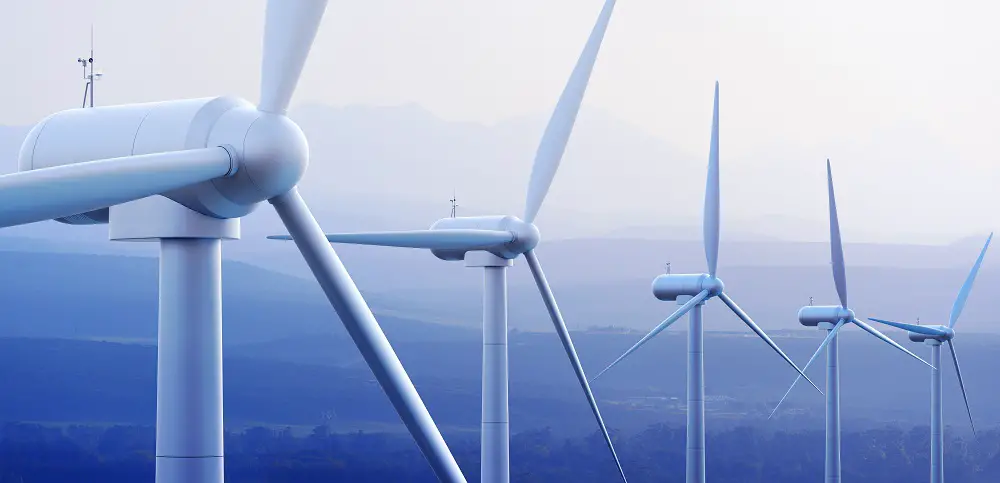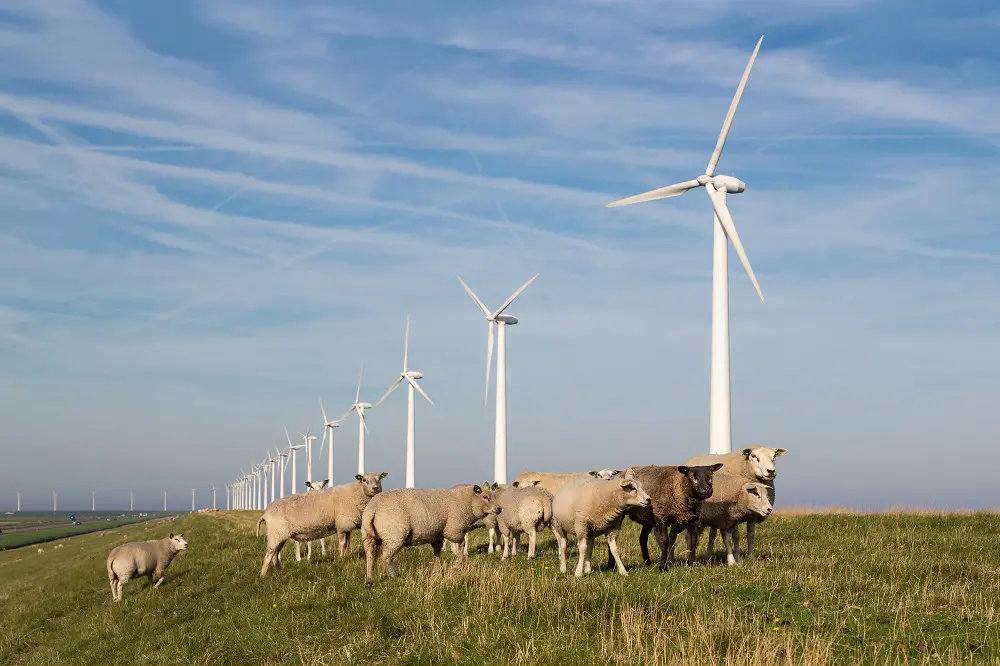The vast majority of wind turbines seen around the county on wind farms (both on-shore and off-shore) are standard 3 blade designs.
The 2 main types of turbines are Horizontal-axis Turbines (HAWT) and Vertical-axis turbines (VAWT).
HAWT have the rotating axis oriented horizontally. They typically feature 3-blades and are designed to face to the wind. VAWT have the rotating axis aligned vertically and are designed to harnesses kinetic energy in the opposite direction.
Apart from HAWT and VAWT there are other iterations of the turbine that are worth exploring.
Horizontal Axis Wind Turbine or HAWT
The most common type of wind turbine is the ‘Horizontal Axis Wind Turbine’ (HAWT). It is referred to as a horizontal axis as the rotating axis lies horizontally (see diagram, below).
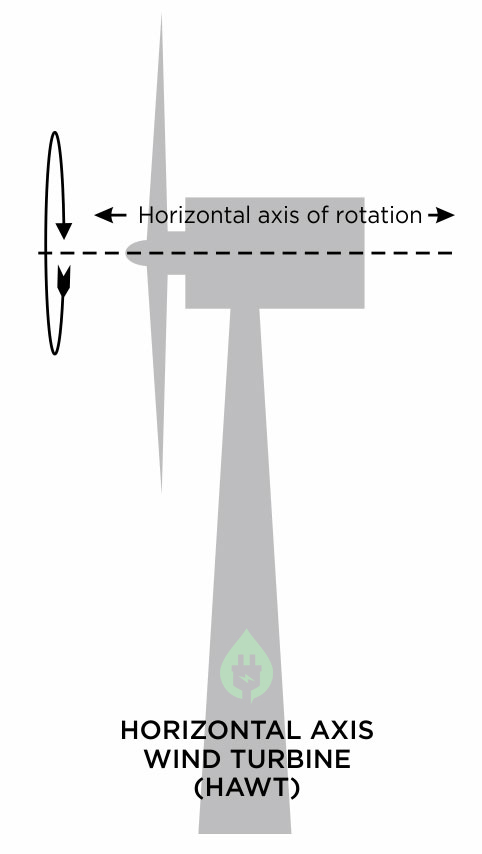
A HAWT needs to point directly into the wind to operate at maximum efficiency, and the whole head is designed to turn to face the wind. As the wind changes direction, so the head must turn (or ‘yaw’) to stay pointing into the wind.
HAWTs are chosen for off-shore wind farms and on-shore wind farms where the land is largely flat and open, because they work more efficiently than VAWTs in areas where the wind is not turbulent.
Built for Size
While there are plenty of small-scale HAWTs commercially available for energy conscious home owners, one of their big advantages is that they scale well for manufacture and can be built VERY BIG. This is another reason why they are used for wind farms. It is much more cost effective to build and operate one 10 megawatt (MW) turbine than five 2 MW turbines.
The largest wind turbine in the world (as of Summer 2021) is the Vestas V236 turbine1, with a rated power output of 15 megawatts (MW). It has a blade rotor diameter of 236m – more than twice the height of the Statue of Liberty! One single rotation of its blades will provide enough electricity to run an average household for a day.
Vertical Axis Wind Turbine or VAWT
A less efficient and less common turbine is the ‘Vertical Axis Wind Turbine’ (VAWT). It is referred to as vertical axis as the rotating axis is aligned vertically upwards (see diagram, below).
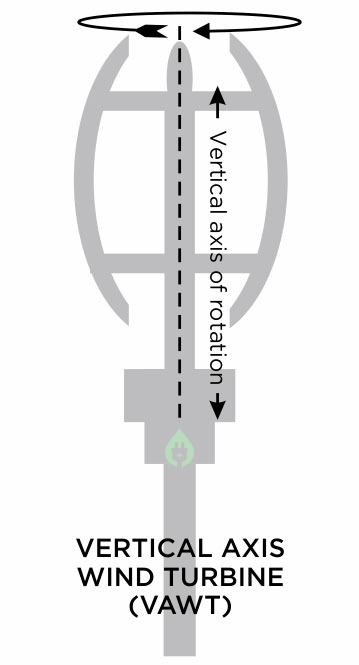
It is not possible to build VAWTs at the large scales we see in HAWT wind farms. The biggest VAWT ever built was the 110m tall, 3.8MW “ÉOLE” turbine in Quebec, Canada2. However the rotor bearing failed in 1993 under the 880 ton weight it had to support. It has been non-operational since then, and is now a curiosity for tourists. It is highly unlikely anyone will try to build a VAWT bigger than this due to the engineering problems associated with directly supporting such heavy weights on a single bearing.
Built for Flexibility
Although smaller, the main advantage that VAWTs have over HAWTs is that they do not need to yaw. They collect wind energy from all directions all the time. Because of the way the blades are designed, they always spin the same direction, no matter where the wind is coming from.
This makes VAWTs better at capturing wind energy in city rooftops and built up areas where turbulent wind is changing direction all the time.
VAWTs take up less room than an equivalent power HAWT, and are often chosen for areas where space is limited.
Learn More: How are Wind Turbines Spaced?
Different Types of VAWTs
There are two main designs of VAWT, called Savonius and Darrieus. These designs are quite different in the way they capture the wind energy.
Savonius VAWTs
Savonius style VAWTs use the principle of drag to convert wind energy into mechanical rotational energy. They work like a scoop, shaped to trap the wind entering the turbine, creating drag and thus forcing it to rotate (see diagram, below). No matter which direction the wind is coming from, it will always hit both the front and back of the scoop – but the rounded back of the scoop creates less drag, thereby allowing the turbine to rotate. However, this does mean that a Savonius VAWT can only convert at best 15% of the wind energy into mechanical rotational energy.
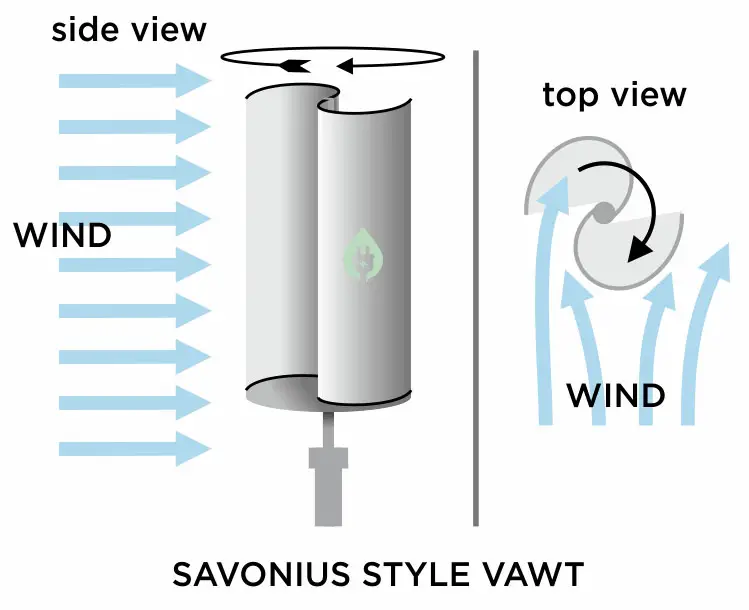
Darrieus VAWTs
Darrieus VAWTs use the principle of lift to convert wind energy into mechanical rotational energy, and are more efficient than Savonius style VAWTs. Darrieus VAWTs use blades that have a cross-section shaped like the wing of an airplane. As the wind passes over the blade, the aerofoil effect creates lift, and this is what rotates the turbine (see diagram, below).
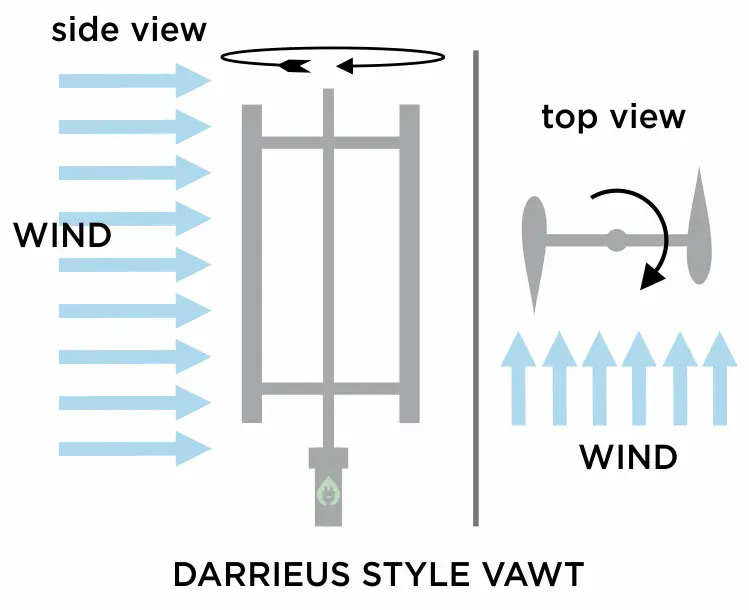
The aerofoil blades of a Darrieus turbine can either be straight, curved, or helical in shape (see diagram, below).
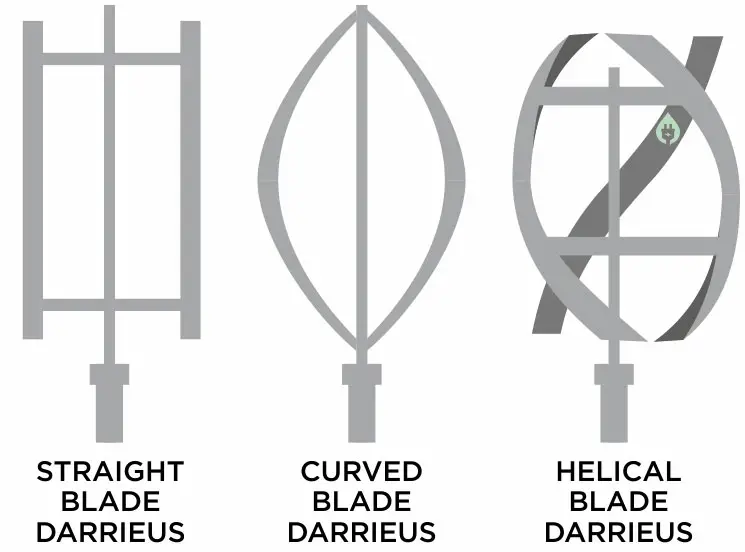
These are all Darrieus turbines – the rotor blades are all the same lift-creating aerofoils, but in different configurations.
The helical configuration is perhaps the most interesting, since it allows a longer aerofoil blade to be contained within the same rotational area as a straight-bladed turbine, thereby capturing more of the wind and increasing efficiency.
Other Turbine Designs
While the majority of turbines fall under these two main categories (VAWT and HAWT) there have been various experimental designs that move away from the normal configuration of these two designs.
The Wind Tree
The ‘Wind Tree’ built by Paris-based company New World Wind, is based on a Savonius VAWT, but it is novel in that it uses many small turbines arranged to look like leaves on a tree to make a decorative urban feature.
Vortex Bladeless
Vortex Bladeless is a Spanish company that have utilized a completely different method for extracting kinetic energy from the wind. Their “turbine” doesn’t look like a conventional turbine at all, as it doesn’t rotate.
The Vortex Bladeless system uses a tall, pillar-shaped mast, which extracts energy from the wind using a technique called vortex-induced resonance. As the wind passes the pillar, it causes turbulence behind it, which causes the pillar to oscillate or ‘vibrate’ back and forth, and it is this mechanical energy that drives a linear alternator, thus generating an electric current.
As they have no rotating blades, this style of wind-generator does not present a danger to migrating birds or wildlife.
Vehicle-Powered Turbines
A number of companies have begun developing small-scale VAWTs that can be placed in the central reservation of highways and freeways. Rather than being driven by ‘natural’ wind, it is the turbulence caused by the constant stream of vehicles passing at high speed that rotates these turbines. So, whilst they are still conventional VAWTs, it is the situation they’re being applied to that is novel.
Cross-axis wind turbine (CAWT)
The cross-axis wind turbine is an experimental VAWT design that uses both horizontal AND vertical turbine blades in a novel cross-linked configuration. With three vertical blades and six horizontal blades, it can capture wind energy coming from both horizontal and vertical directions. Studies found it was 2.5 times more efficient than a conventional VAWT in the same wind conditions.
Cooling Tower Updraft Turbine
This design proposes a novel configuration of a Darrieus VAWT, orientated horizontally and situated at the top of cooling towers. The updraft from the exhaust air flow from the tower, rather than being wasted to the atmosphere, is used to drive the turbine.


